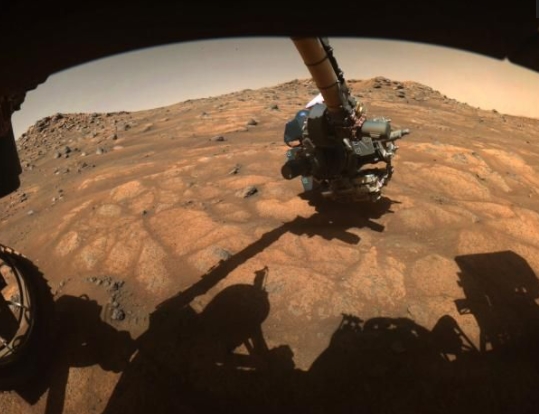NASA’s Perseverance rover gears up to capture its 1st Mars rock sample

NASA’s Perseverance rover is preparing to collect its first samples on Mars, a milestone that could happen within the next two weeks, agency officials announced today (July 21).
Perseverance landed on the Red Planet in an ancient lake bed known as Jezero Crater on Feb. 18 to explore and scour the planet for signs of ancient life. To do this, the rover was designed to collect and store samples of Martian material to be returned to Earth by a mission in the early 2030s.
After beginning its science phase June 1 and exploring a 1.5-square-mile (4 square kilometers) region of the crater floor, Perseverance will take its first samples in an area known as the “Cratered Floor Fractured Rough.”
Related: New photos from the Mars helicopter Ingenuity’s 9th flight help refine Perseverance rover science goals
“When Neil Armstrong took the first sample from the Sea of Tranquility 52 years ago, he began a process that would rewrite what humanity knew about the moon,” Thomas Zurbuchen, NASA’s associate administrator for the science mission directorate said in a NASA statement. “I have every expectation that Perseverance’s first sample from Jezero Crater, and those that come after, will do the same for Mars. We are on the threshold of a new era of planetary science and discovery.”
“I just can’t tell you how excited I am,” Zurbuchen added during a news briefing today. He added that these months of exploration have laid “the groundwork for one of the most ambitious campaigns yet,” referring to the partnership with the European Space Agency to bring those samples back to Earth.
A photo snapped by NASA’s Perseverance rover on Mars.
A photo snapped by NASA’s Perseverance rover on Mars. (Image credit: NASA/JPL-Caltech)
Collecting and studying bits of Mars
Perseverance will take approximately 11 days to collect its first sample, which it will do using its 7-foot-long (2 meters) robotic arm to first image and survey the site to determine an exact sampling location, then collect the material into a sampling tube. Shortly after the rover takes its first sample, it will take a second sample at a different target in the same general area for “proximity science,” or additional science, according to the NASA statement. The samples will each be finger-size cylinders stored in tubes.
The rover will then store the full tubes within its body for now; The location and date of their transfer to the sample-return mission is yet to be determined, Perseverance project scientist Ken Farley told Space.com in today’s briefing.
“Over the coming year, we will collect four unique samples, and we will keep them on board, we will carry them to a site which is not yet determined where we will cache them for future pickup,” Farley added.
While the samples will be thoroughly investigated once on Earth, Perseverance’s on-board technology will still be able to learn quite a bit about the rocks by studying the sampling sites.
Among other instruments on the rover are SHERLOC (Scanning Habitable Environments with Raman & Luminescence for Organics & Chemicals), PIXL (Planetary Instrument for X-ray Lithochemistry) and the camera WATSON (Wide Angle Topographic Sensor for Operations and Engineering). Using these three pieces of technology and other cameras, the rover can conduct mineral and chemical analysis of the site as well as collect detailed, high-resolution imagery.
7 minutes of terror: See the nail-biting Mars landing of the Perseverance rover
A Red Planet road trip
To get to this pivotal point in the mission, Perseverance has been going on what team leaders today described as a “road trip” across the Martian surface.
“We have a destination, we have a set amount of time, and we also have a lot of points of interest that are nearby or along the way that we really want to go and see,” Vivian Sun, the Perseverance science campaign co-leader, said today. The challenge, she described, is deciding “exactly where we want to go and how we’re going to fit everything into our schedule.”
The team has now selected their “road trip” sampling destination and an additional three points of interest along the way and, NASA announced today, they aim to take their first Martian sample within the next two weeks.
The rover will capture its first samples in an area known as the Cratered Floor Fractured Rough, which is about 3,000 feet (900 meters) south of where Perseverance landed in Jezero Crater, an area known as the Octavia. E Butler landing site.
The material here is crater terrain, Sun explained, “very similar to the terrain that you see on the moon.” The rover will also sample lighter-toned rocks that are usually covered by sand and dunes. “These are the two major rock types that we’re really investigating in this first science campaign,” Sun said.
Click here for more Space.com videos…
Searching for science
Although a main science objective for Perseverance is to find evidence of ancient life on Mars, these samples will also provide scientists with data to explore the planet and its history.
“Not every sample Perseverance is collecting will be done in the quest for ancient life, and we don’t expect this first sample to provide definitive proof one way or the other,” Farley said in the statement. “While the rocks located in this geologic unit are not great time capsules for organics, we believe they have been around since the formation of Jezero Crater and incredibly valuable to fill gaps in our geologic understanding of this region — things we’ll desperately need to know if we find life once existed on Mars.”
To make the most out of their samples, the team wants to collect a sample that could represent the larger area. “We want this sample to really kind of summarize and record the history of this entire unit as much as possible,” Sun said in the conference. In particular, the Perseverance scientists want their sample “to have kind of the typical texture, chemistry and mineralogy as all the other crater floor fractured rock rocks that we have explored and seen so far on our trip.”
In fact, sampling this rock could solve a mystery that has been plaguing the mission team. While this crater is the site of an ancient lake, where scientists expect to find sedimentary rock, the team thinks that this region could possibly be volcanic rock instead.
“We still don’t know if it’s an igneous rock, like a volcanic flow, or if it’s a sedimentary rock that was deposited by air or in water,” Sun said. “And, of course understanding the origin of this Crater Floor Fractured Rock unit is going to be critical to not only reconstructing the history of this lake that used to be here but also it’s important for understanding the geologic history in general as well as the area around Jezero in this region of Mars.”



 Creators of mankind
Creators of mankind Description of “Tall white aliens”
Description of “Tall white aliens” Where they came from?
Where they came from? About hostile civilizations
About hostile civilizations The war for the Earth
The war for the Earth “Tall white aliens” about eternal life
“Tall white aliens” about eternal life Video: “Nordic aliens”
Video: “Nordic aliens” Aliens
Aliens Alien encounters
Alien encounters The aliens base
The aliens base UFO
UFO Technology UFO
Technology UFO Underground civilization
Underground civilization Ancient alien artifacts
Ancient alien artifacts Military and UFO
Military and UFO Mysteries and hypotheses
Mysteries and hypotheses Scientific facts
Scientific facts


















